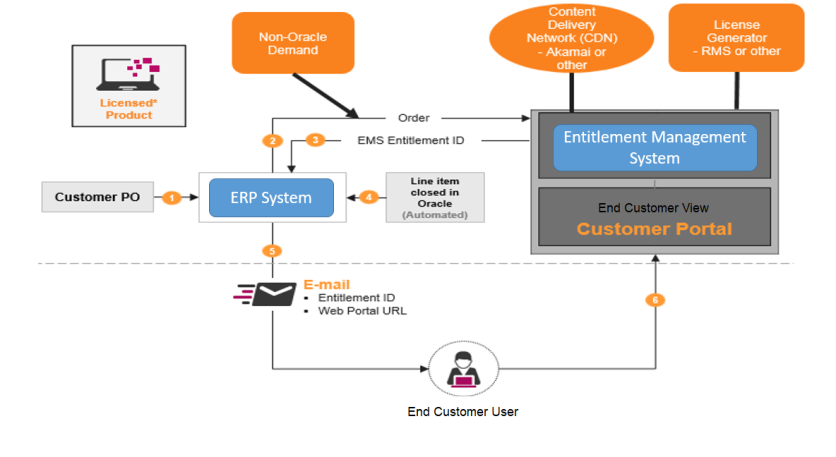In today's world, marked by numerous technological advancements, automated virtual product delivery stands out as a vital component for business survival, given the paramount importance of efficiency and precision. Gopal Pagrut emerges as a visionary leader in this domain, spearheading transformative initiatives that usher in a new era of delivering virtual products such as software, licenses, and services.
Gopal Pagrut's Vision
Pagrut recognized the challenges in delivering virtual products like software, licenses, and services, which traditionally required manual processes. With a clear vision, he aimed to create a more efficient and scalable back-office solution to achieve a 100% automated process, significantly reducing delivery times and manual errors.
In the past, these deliveries required cumbersome manual processes, but the shift towards virtual solutions clarified the need for a more efficient and scalable back-office solution. Pagrut, understanding this need, leveraged Software Monetization technology and improved back-office system integration. His strategic approach streamlined the fulfillment workflow, resulting in a remarkable outcome-a fully automated process.
Now, businesses can deliver virtual products swiftly and efficiently, meeting customer demands promptly and with minimal manual intervention. Manual errors have been eliminated, and resource requirements have been reduced, increasing operational efficiency and cost-effectiveness. This successful transformation, spearheaded by Pagrut, has empowered businesses to thrive today, symbolizing technological advancement and a revolutionary step in how companies operate and serve their customers.
5 Key Steps in Implementing Automated Virtual Product Delivery
Pagrut's innovative strategies have seamlessly integrated with back-office systems, including ERP and middleware flows. The entire process, from purchase initiation to entitlement creation, sales order closure, and email notification to the customer, now takes place without human intervention, resulting in increased operational efficiency and cost-effectiveness.
Here are the five key steps:
Identify the current product delivery process: Assess the existing process for inefficiencies, inaccuracies, or complexities.
Evaluate the current process: Identify areas that can be improved.
Design the new process: Determine necessary changes to boost efficiency, accuracy, and usability.
Implement the new process: Train staff and ensure the right tools and systems are in place.
Monitor and evaluate the new process: Track customer satisfaction, error rates, and processing times.
Streamlining Software License Delivery Using Automated Virtual Product Delivery in ERP
When a customer makes a purchase in the ERP system, it sets off an automated process:
The ERP system initiates workflows for entitlement creation, sales order closure, and email notification.
Middleware in the ERP system automatically creates an entitlement in the system.
The entitlement system provides an entitlement ID and related details.
The sales order line item in the ERP system is closed.
The ERP system emails customers about their purchases and provides the necessary details.
The customer then generates and downloads the license using the provided entitlement ID.
This automation ensures efficient, error-free software license delivery, enhancing the customer experience and operational efficiency (as below).

Benefits of Automated Virtual Product Delivery for E-Commerce
Integrating back-office systems streamlines order processing and reduces lead times, elevating the customer experience and operational efficiency. This automation negates manual intervention, slashing error risks and delivery delays.
Shifting from honor-based to enforced licensing ensures only authorized product access, reducing misuse. Automated systems manage renewals, extensions, and additional orders effortlessly, minimizing administrative tasks. Potential customers can easily access trial licenses, boosting conversion rates.
By eliminating the need for manual labor, businesses save costs and optimize resources. The delivery accuracy ensures customers receive the correct products promptly, enhancing their satisfaction and loyalty.
Critic's Perspective on Automation in Virtual Product Delivery
The rapid evolution of business operations under leaders like Gopal Pagrut has its critics. Many caution against the pitfalls of complete automation, fearing reduced human oversight might make systems susceptible to errors or manipulations. The essence of personalized customer service, they argue, risks erosion as efficiency becomes paramount. In this age of swift product delivery, the challenge may lie in maintaining a delicate balance between automation and the cherished human touch.
Countering these concerns, Gopal Pagrut highlights the undeniable benefits of automation. With a 100% automated process, errors are reduced, and delivery times decrease dramatically. This ensures businesses meet customer demands efficiently.
Pagrut cites milestones like substantial cost reductions and accelerated delivery as proof of automation's merits. While valuing human interaction, he envisions automation as an enabler, allowing businesses to allocate saved resources towards enhancing customer relationships, thereby merging efficiency with personal touch.
Challenges, Prospects, and Technical Limitations
Although automated delivery systems offer numerous advantages, challenges are inherent within them. Nonetheless, the path ahead holds promise and transformation, driven by ongoing technological progress and a comprehensive grasp of potential obstacles. The future of automated virtual product delivery seems bright and revolutionary, propelled by these factors.
While undoubtedly noteworthy benefits exist, automated virtual product delivery surmounts several significant technical limitations. One such challenge pertains to effectively managing error records. Presently, a pressing issue revolves around the automation of resending error records; a robust error notification mechanism that includes precise error messages is imperative to prompt appropriate actions. Moreover, tackling alterations or upgrades to the database schema poses another substantial hurdle. Seamlessly upgrading all systems without interrupting or causing downtime in the end-to-end automatic delivery process raises important questions and necessitates innovative solutions.
Privacy, Security, and Trust Concerns
Security concerns have become more pronounced due to the increased dependence on technology and data sharing. Automated systems collect large amounts of customer data, such as location information, purchase history, and personal preferences. With the reliance on technology, it is also essential to ensure the customers' secure handling, storage, and data transmission. Securing customer data is also critical in maintaining customer trust. Using robust cybersecurity measures and adhering to strict privacy regulations will be important in addressing these concerns.
Public acceptance and trust play a crucial role in the proliferation of automated virtual product delivery. Job losses, safety concerns, skepticism, and fear of the general reliability of automated systems can hinder public acceptance. Educating the public about the benefits, safety measures, and potential employment opportunities associated with automated delivery systems is critical to building trust and acceptance.
Embracing the Future
Gopal Pagrut offers innovative strategies to integrate back-office systems for efficiency and precision. This transformation has eliminated manual intervention and heralded a new generation of efficiency and accuracy. Such an effort led to significant cost savings, with the company's expenses decreasing from €34,000 in 2017 to €262,000 in 2018. Additionally, product delivery times were significantly reduced from 2.8 days to just 1 hour.
Automated virtual product delivery represents a revolutionary step in product transportation and delivery. Although it comes with concerns and limitations, innovative leaders like Gopal Pagrut have shown that these can be addressed, unlocking substantial benefits. As such, embracing these advanced technologies positions organizations to thrive in the digital era.
ⓒ 2026 TECHTIMES.com All rights reserved. Do not reproduce without permission.




